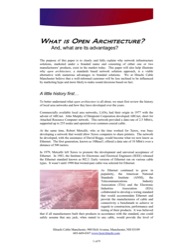
The attached PDF was written by Hitachi Cable Manchester (HCM) and details the benefits of open architecture in network infrastructures.
In infrastructure design there are two major schools of thought: open architecture and closed solutions. On one hand, open architecture is the idea that any jack, patch cord, or cable, regardless of manufacturer, should work together and deliver the specified level of performance with no loss. On the other hand, a closed solution means all components are designed by the same manufacturer ( or sometimes a couple manufacturers) and are optimized to work as one complete system.
Proponents of closed solutions say this is the best method for building a optimized infrastructure. And this makes sense considering each component is designed specifically to work with the other from its inception. But there are two sides to every argument.
In the attached PDF entitled "What is Open Architecture?", benefits of open architecture are explained while a few drawbacks of closed solutions are detailed. One drawback mentioned is in regards to warranties closed solutions sometimes offer. From the article: "The closed solution warranties can be comprehensive, but they can also be very restrictive. Virtually all closed solution warranties restrict future moves, adds and changes to the network in ways that are not always in the best interest of the end user.[...] One could argue that this restriction helps keep inferior products and or installers from interacting with the warranted products. It can also help exclude competition and ensure that the end user only buys solution products."
This ongoing debate is analogous to the whole PC versus Mac argument which has been waged for ages. PCs are designed to work with all types of hardware and PC users are big supporters of the Open Source movement (software and hardware is open for anyone to improve or customize). Taking the opposite approach, Macs are notoriously closed to all other hardware manufacturers, but all components were specifically designed to work together seamlessly. There is no right or wrong choice here, only which solution works best for you. Do you want customization and the ability to design your own machine or would you rather have one system designed to be complete? This is just like open architecture and closed solutions.

The attached article is definitely an argument for open architecture, but the point here is present another option for customers. There are those who will always be closed solution proponents and there are those who would rather have an open architecture, it's just that simple. "What is Open Architecture" is a well written piece and does an excellent job of detailing the benefits of open architecture. Regardless of which solution you're in favor of, this article is worth the read.
The decision as to which solution you prefer is ultimately up to you. I'm not arguing in favor of one method over the other, I only want to present as many options for readers as available. In the end, it's up to your customer to decide which solutions best meet their needs.


.png?width=58&height=58&name=X_logo_2023_(white).png)
